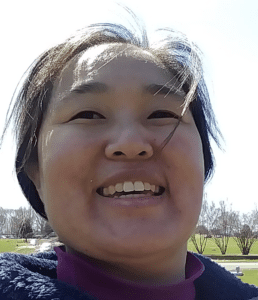Posted By: Sara Cullinan, PhD, Deputy Editor, AJHG
Each month, the editors of The American Journal of Human Genetics interview an author of a recently published paper. This month we check in with Ani to discuss her paper “Polygenic transcriptome risk scores for COPD and lung function improve cross-ethnic portability of prediction in the NHLBI TOPMed program.”
SC: What motivated you to start working on this project?

AM: This project grew out of synergy with a few of our existing collaborations and the confluence of those lines of research. We have been working with Haky Im over the past few years on application of her PrediXcan method to interpret the biological implications of GWAS signals. We have also been working together with Heather Wheeler on the use of PrediXcan for diverse ancestry populations, and special considerations in this context, including cross-ancestry portability of gene expression prediction. Finally, we have been working closely with Michael Cho and others in the Trans-omics for Precision Medicine (TOPMed) Lung Working Group on gene mapping and risk prediction for Chronic Obstructive Pulmonary Disease (COPD). Building on these lines of research, we started thinking about how we could leverage integrative methods that combine gene mapping with other types of ‘omics data to improve cross-ancestry portability of risk prediction, and for prediction of COPD risk in particular. Once we started thinking along these lines, the project pretty much grew from there.\
SC: What about this paper/project most excites you?
AM: It was exciting to see Xiaowei Hu (lead author on this publication) put the pieces together for the main idea and keep the momentum going! Since the project tied together a few of our group’s different research interests, it was also very fun to see some of our different collaborators from distinct consortia start to get to know each other and develop close working relationships.
Conceptually, the process of communicating our work to other genetics researchers and the larger scientific community was a constant source of motivation for the project. Along the way, we have gotten push-back many times on concepts that are central to this work including questions about the value of genetic risk prediction in general, the feasibility of building genetic risk prediction models in one population and carrying to another, and the ethics of reporting estimates of genetic risk to individuals for whom those risk estimates may not be very accurate. Building on the current work to contribute to these larger conversations has been very exciting and continues to motivate us to work further on this research.
SC: Thinking about the bigger picture, what implications do you see from this work for the larger human genetics community?
AM: Our current work underscores the potential of leveraging integration with diverse ancestry molecular ‘omics data to improve portability of polygenic risk scores. There are numerous lines of research that can build on what we’ve done here including leveraging integration with other types of ‘omics, including proteomics, genome-wide methylation, or metabolomics, in addition to the transcriptomes that we leveraged in our present work. Further, our work represents a proof-of-concept for the value of these approaches and underscores the need for greater investment in diverse ancestry molecular ‘omics data that our larger genetics community could leverage in so many different ways! Finally, while we have focused on application of the integrative framework for prediction of COPD risk, there is potential for use of the approach in the context of other diseases, and that is an area of research that we’d like to pursue in the near future.
SC: What advice do you have for trainees/young scientists?
AM: My advice to the next generation of scientists is prioritize how you spend your time and energy. With so many technologies available to facilitate research, there are increasing opportunities to do exciting work. Prioritizing can help to you to focus and make progress on the projects that are most meaningful to you. Identifying your priorities also inevitably means that you’ll have to say “no” to some efforts or collaborations. Finally, remember to have FUN and take time to enjoy the excitement of your discoveries and small successes at the end of each day!
SC: And for fun, tell us something about your life outside of the lab.
AM: Outside of work, I love experimenting in the kitchen. Living in Charlottesville, Virginia, I don’t have access to restaurants with all of my favorite international foods, but we do have so many sources of fresh local ingredients! I spend many of my weekends trying to re-invent foods I enjoyed while growing up in the DC area.
